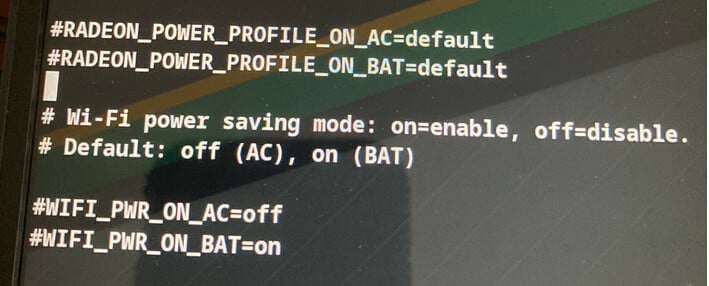TLDR:
-
Trackpads without two mouse buttons suck, and I don’t care if Apple does it.
-
Wifi has to work reliably because if it doesn’t you can’t even use your fancy laptop as a tablet.
After several freshly installed recent distros, including one of the recommended ones, I find the result to be a big disappointment. I use the trackpad in non-touch mode which means that I have to press to do mouse clicks, and the location of the left and right mouse button is a complete crapshoot as far as I am concerned. I wind up hunting around random left-ish and right-ish places but the result is almost impossible to use. I absolutely have to have a wireless mouse to have any sense of utility, which is not true for my daily driver which is an ASUS ROG on windows. That trackpad also sucks compared to a mouse but it sucks much less and the apparent places to click at least stay where they are and make some kind of sense.
The wifi only works reliably in the same room as the router. In my room upstairs it drops connection every 20 or 30 minutes. I have 5 and 2.4 and sometimes it will connect to one and not the other. Which one is a crapshoot. I do not have this problem on an ancient elitebook or my ASUS, nor do I have it on an Air.
Since the wifi problem is distro-agnostic I assume that one of two things is true: the driver interface is some kind of slapped-together approximate thing because the manufacturer has not supplied the needed detail or the antenna is seriously not working. Or something else I haven’t thought of. I actually spent money to upgrade my router in order to use my laptop upstairs on 2.4 (Spectrum router won’t let you expose 2.4) but no! It didn’t even matter for the framework but everybody else upstairs had better internet as I did on my ASUS. Whine, whine, whine …
So do I load windows on this thing in order to see if there is a better trackpad driver and wifi driver in windows? For Linux, do I try to find a HW compatible wifi card that has a robust, working linux driver and just forget about the trackpad and attach a wireless mouse to the laptop with a string? I can’t find docs on the trackpad software interface with a cursory search although I haven’t yet tried to pretend to be a volume manufacturer in order to get some scraps of information from the supplier. I’m too old for this kind of bullshit that I have done over and over again many times before. I just wanted basic stuff to not suck and that has not proven to be the case for Linux on this device.
This is more than just a monetary hit: I wanted the display aspect ratio because these days everything on the web is designed to look OK on cellphones to the detriment of people looking at wide aspect ratios, and everything with a big screen has wide aspect ratios. We are living in the smartest, stupidest age for design that has ever existed, where the best ways to do some things, that used to be obvious, are passed over for new shit that is trendy and is primarily used to facilitate the extraction of rent from the masses.
The DeLorean is a great car to climb out of in the Starbucks parking lot in Palo Alto for the admiring glances but it will (probably) cost you boatloads of time and money to keep on the road. OTOH the Miata is not only fun to drive but it is actually a great car that for a “sports car” is cheap to maintain. I say that as a former owner of the latter who wanted to show up for work at the local joint with the spiffy laptop that is different from all the other aluminum laptops. The DeLorean. A really cool and innovative piece of HW.
Nope, it’s back to the Miata for me.



